Wouldn’t it have been nice, I was thinking to myself at the end of a day at the Nanyuan Land of Retreat and Wellness (南園人文客棧), if we had been completely free to walk among the traditional southern Chinese Jiangnan-style architecture, roaming at our own leisure through the rooms tastefully decorated with carved scenes of folk tales and auspicious emblems, in buildings constructed of native Taiwan cypress wood.
We could easily have spent a large chunk of the day wandering the 27-hectare site of landscaped gardens, with the arched bridges traversing sculpted ponds, passing the white painted walls punctuated with window openings fashioned in auspicious shapes.
The setting is certainly there in the Nanyuan resort, which is run by “lifestyle brand” The One out in remote Sinpu in Hsinchu County. The kicker is, why couldn’t we just be left to it?
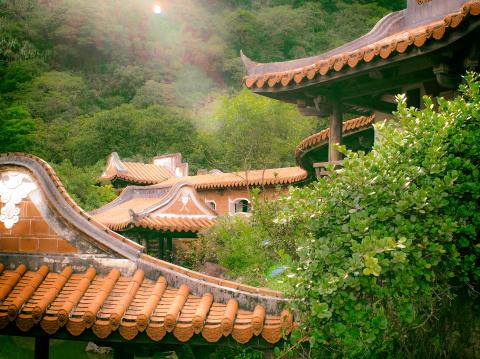
Photo: Paul Cooper, Taipei Times
To be fair, I should start with what The One gets right, because we really did enjoy the day spent there.
Even before you arrive, The One has sent you messages confirming your booking with detailed directions to get there (if driving), together with a weather report (slight chance of rain) and recommendations on what to wear (sensible shoes).
Should you be coming by train, they have also provided the contact number of a taxi driver who will meet you at the station. We booked him, and found him to be polite, punctual, helpful and well-informed.
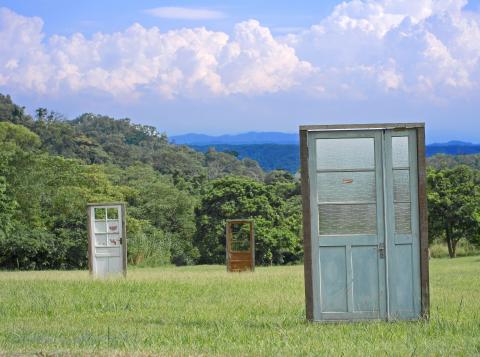
Photo: Paul Cooper, Taipei Times
It’s also worth considering arranging for him to pick you up at the end of the day. The location is quite remote and finding return transportation might be difficult.
When we arrive, we are led into a reception area with the others in our scheduled group, our designated companions for the day, waiting before being treated to an introduction to the tour, with tea and biscuits — which are quite good — and then taken off for a look at the premises.
The tour — also available in English, if booked in advance — is divided into two manageable parts, before and after lunch. The tour through the rooms was well-presented, informative and engaging: enough that my friend wanted to join the second instalment, which took the group out into the sprawling 27-hectare grounds. We were shown a statue of United Daily News Group founder Wang Ti-wu (王惕吾) and a pleasantly bizarre open-air art installation consisting of free-standing doors placed in seemingly random formation in a field.
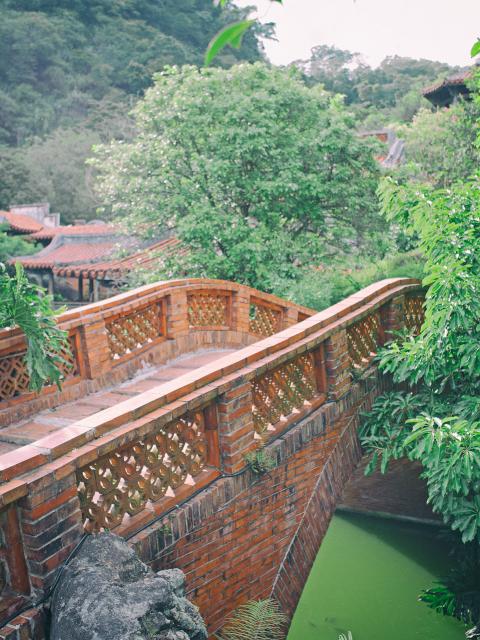
Photo: Paul Cooper, Taipei Times
At this point we drifted away from the group, and finally managed to spend some time walking around the gardens by ourselves — feeling strangely naughty for doing so, like we were somehow playing truant.
A bit of background
The Nanyuan resort, with its landscaped gardens and southern Chinese Jiangnan style architecture, was constructed as a retirement home for Wang. It was overseen by the renowned Shandong-born architect Han Pao-teh (漢寶德), who moved to Taiwan in 1952. Construction on the site started in October 1983 and was completed in September 1985.
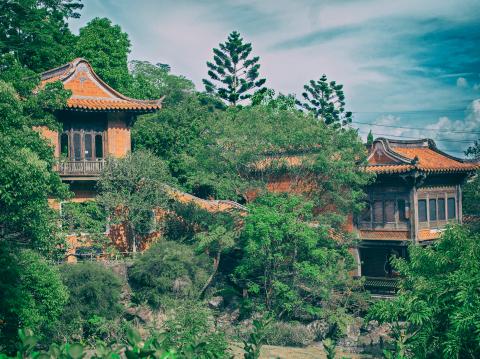
Photo: Paul Cooper, Taipei Times
The resort was officially opened to the public in March 2007, and soon after The One was commissioned to reinvent the area as a leisure retreat. It was officially opened to that purpose in December 2008.
Wang passed away in 1996, but during the time he spent here he received many illustrious guests from overseas, including former UK prime minister Margaret Thatcher in 1992 and former former Soviet Union president Mikhail Gorbachev in 1994.
You can imagine how these guests would have dined in one of the pavilions overlooking the pond with its arched bridge. Not, perhaps, in the school canteen-looking building we were led to for lunch.
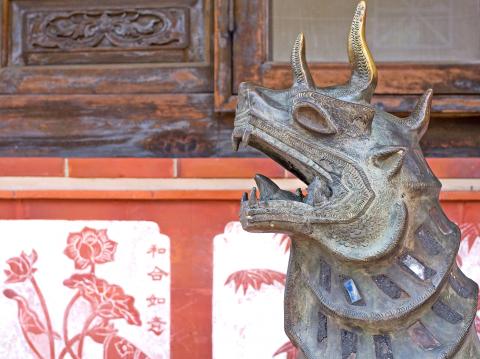
Photo: Paul Cooper, Taipei Times
This is where we felt that the concept of the tour and the scheduled itinerary stumbles.
The lunch itself was pleasant. It is a set menu, but the food is made from healthy ingredients and presented as Hakka-themed fusion cuisine.
We had Hakka pancakes with fermented tofu, bamboo shoots with pesto, miso vinegar and Iberico de Bellota, followed by tofu and pumpkin and then Hakka chicken rice. You can ask for more helpings if you are not quite satiated. Even the cutlery and crockery, designed in-house (and available for purchase) — enhanced the dining experience.
It’s just that the rather prosaic, functional surroundings in which lunch was served felt like a bit of a missed opportunity, given the exquisite architecture and landscaped gardens you had just come from.
And so it was for the whole experience, really. The interiors are wonderful, the gardens and architecture aesthetically pleasing, the schedule well organized, the staff amiable, the tour engaging, the service excellent. But it all feels a little too managed, too regimented. Like being on a school trip. Like not being trusted to touch anything, lest you break it.
The Nanyuan resort also offers overnight accommodation, which is presumably a different experience altogether. And don’t get me wrong: if you just want to spend an afternoon in a beautiful traditional Jiangnan-style landscaped garden, and to have a tour of the buildings, it is well worth the trip. But we wondered where the repeat business comes from. A few years ago it was possible to pay an entrance fee and just enjoy the gardens. That is no longer on the table, unfortunately: visitors have to sign up for the whole package. It’s your call whether you would want to pay the price to do it all again.
Info for day trip
Getting there
- Nanyuan Land of Retreat and Wellness (南園人文客棧) 32, Jiuqiong Lake, Sinpu Village, Hsinchu County (新竹縣新埔鎮九芎湖32號). If you get lost, you can call 03-5890011, ext 3.
- Day tickets are NT$1,408, with two hour (Chinese) tour, lunch and afternoon snacks included. Advance reservations recommended.
- English-language group tours of up to 30 people should be booked in advance and are available at an additional cost of NT$3,000.
- High Speed Rail from Taipei to Hsinchu Station (新竹高鐵站). Frequent trains, around 35 mins.
- Transfer to taxi (The One will recommend a driver when you book) from Hsinchu HSR, around NT$350, roughly 30 mins to resort. Consider arranging a return journey with the driver.

No one saw it coming. Everyone — including the Chinese Nationalist Party (KMT) — expected at least some of the recall campaigns against 24 of its lawmakers and Hsinchu Mayor Ann Kao (高虹安) to succeed. Underground gamblers reportedly expected between five and eight lawmakers to lose their jobs. All of this analysis made sense, but contained a fatal flaw. The record of the recall campaigns, the collapse of the KMT-led recalls, and polling data all pointed to enthusiastic high turnout in support of the recall campaigns, and that those against the recalls were unenthusiastic and far less likely to vote. That

Behind a car repair business on a nondescript Thai street are the cherished pets of a rising TikTok animal influencer: two lions and a 200-kilogram lion-tiger hybrid called “Big George.” Lion ownership is legal in Thailand, and Tharnuwarht Plengkemratch is an enthusiastic advocate, posting updates on his feline companions to nearly three million followers. “They’re playful and affectionate, just like dogs or cats,” he said from inside their cage complex at his home in the northern city of Chiang Mai. Thailand’s captive lion population has exploded in recent years, with nearly 500 registered in zoos, breeding farms, petting cafes and homes. Experts warn the

A couple of weeks ago the parties aligned with the People’s Republic of China (PRC), the Chinese Nationalist Party (KMT) and the Taiwan People’s Party (TPP), voted in the legislature to eliminate the subsidy that enables Taiwan Power Co (Taipower) to keep up with its burgeoning debt, and instead pay for universal cash handouts worth NT$10,000. The subsidy would have been NT$100 billion, while the cash handout had a budget of NT$235 billion. The bill mandates that the cash payments must be completed by Oct. 31 of this year. The changes were part of the overall NT$545 billion budget approved

The unexpected collapse of the recall campaigns is being viewed through many lenses, most of them skewed and self-absorbed. The international media unsurprisingly focuses on what they perceive as the message that Taiwanese voters were sending in the failure of the mass recall, especially to China, the US and to friendly Western nations. This made some sense prior to early last month. One of the main arguments used by recall campaigners for recalling Chinese Nationalist Party (KMT) lawmakers was that they were too pro-China, and by extension not to be trusted with defending the nation. Also by extension, that argument could be